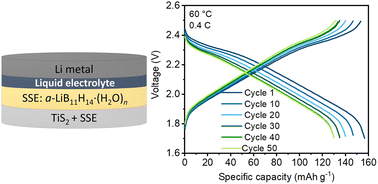Hydrated lithium nido-boranes for solid–liquid hybrid batteries†
Abstract
Hydridoborate salts are considered as promising solid-state electrolyte candidates for the development of solid-state batteries (SSBs). The presence of coordinated water in the crystal structure may facilitate the migration of the cation, yielding compounds with high ionic conductivity. In the present study, two samples of hydrated LiB11H14, here called LiB11H14·2H2O and a-LiB11H14·(H2O)n (n < 2), demonstrate remarkably different properties as solid-state electrolytes. LiB11H14·2H2O is identified as a new class of ionic liquid, as it melts at ≈70 °C, whereas the sample a-LiB11H14·(H2O)n undergoes a polymorphic phase transition close to this temperature, reaching the liquid-like ionic conductivity of 3.2 × 10−2 S cm−1 at 70 °C and an oxidative stability limit of 2.8 V against Li+/Li. Galvanostatic cycling and battery tests were conducted with a-LiB11H14·(H2O)n as the solid-state electrolyte (SSE) at 60 °C with the addition of traces of either the ionic liquid (IL) LiB11H14·2H2O or the liquid electrolyte (LE) 1.0 M LiPF6 EC/DMC (v/v = 50/50) at their interfaces. Galvanostatic experiments for the cell Li/IL/SSE/IL/Li showed an overpotential of only 21 mV after 9 days cycling (48 h at 25 μA cm−2 and 168 h at 50 μA cm−2), and the battery Li/LE/SSE/SSE + TiS2 retained 83% of its capacity shown in the first cycle at 0.4C after 50 cycles. LiB11H14·2H2O and 1.0 M LiPF6 EC/DMC work effectively as wetting agents to improve SSE/Li contact.

- This article is part of the themed collection: Sustainable Energy & Fuels Recent HOT Articles


 Please wait while we load your content...
Please wait while we load your content...